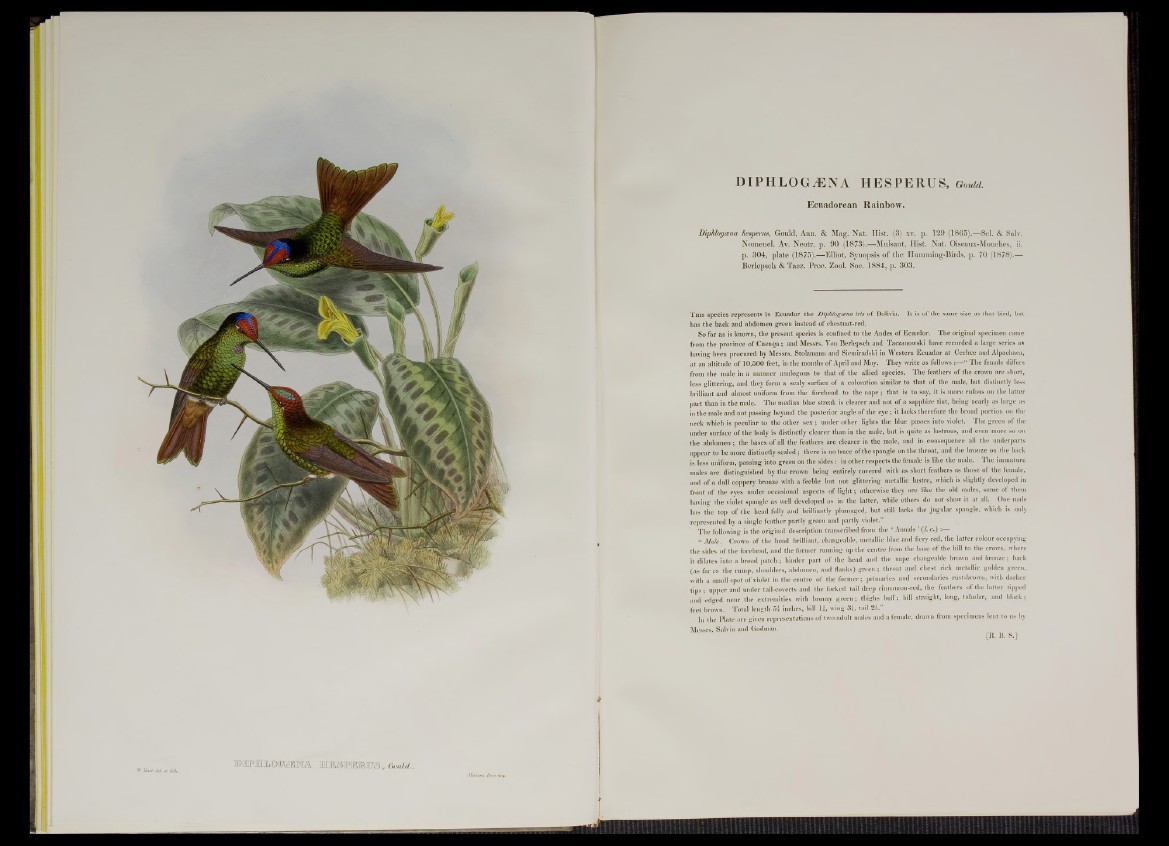
®IPMIL©<EMEK& IE SF IE 1U S , GouU:
DIPHLOGÆNA HESPERUS, Gould.
Ecuadorean Rainbow.
Diphlogtena hesperus, Gould, Ann. & Mag. N a t. Hist. (3) xv. p. 1 2 9 (1865).— Scl. & Salv.
Nomencl. Ay. Neotr. p. 9 0 (1873).— Mulsant, H ist. Nat. Oiseaux-Mouches, ii.
p. 3 0 4 , plate (1875).— Elliot, Synopsis o f the Humming-Birds, p. 7 0 (1878).—
Berlepsch & Tacz. Proc. Zool. Soc. 1 8 8 4 , p. 3 0 3 .
T h i s species represents in Ecuador the DiphlogtBna iris of Bolivia. It is of the same size as that bird, but
has the back and abdomen green instead of chestnut-red.
So far as is known, the present species is confined to the Andes o f Ecuador. The original specimen came
from the province of Cuenga; and Messrs. Von Berlepsch and Taczanowski have recorded a large series as
having been procured by Messrs. Stolzmann and Siemiradski in Western Ecuador at Cechce and Alpachaca,
at an altitude o f 10,500 feet, in the months of April and May. They write as follows:—“ The female differs
from the male in a manner analogous to that o f the allied species. The feathers o f the crown are short,
less glittering, and they form a scaly surface of a coloration similar to that of the male, but distinctly less
brilliant and almost uniform from the forehead to the nape; that is to say, it is more rufous on the latter
part than in the male. The median blue streak is clearer and not of a sapphire tint, being nearly as large as
in the male and not passing beyond the posterior angle of the ey e; it lacks therefore the broad portion on the
neck which is peculiar to the other sex ; under other lights the blue passes into violet. The green of the
under surface of the body is distinctly clearer than in the male, but is quite as lustrous, and even more so on
the abdomen ; the bases of all the feathers are clearer in the male, and in consequence all the underparts
appear to he more distinctly scaled; there is no trace of the spangle on the throat, and the bronze on the back
is less uniform, passing into green on the sides: in other respects the female is like the male. The immature
males are distinguished by the crown being entirely covered with as short feathers as those of the female,
and o f a dull coppery bronze with a feeble but not glittering metallic lustre, which is slightly developed in
front of the eyes under occasional aspects o f light; otherwise they are like the old males, some of them
having the violet spangle as well developed as in the latter, while others do not show it at all. One male
has the top of tile head fully and brilliantly plumaged, but still lacks the jugular spangle, which is only
represented by a single feather partly green and partly violet.”
The following is the original description transcribed from the ‘ Annals | (/. c.)
“ Male. Crown o f the head brilliant, changeable, metallic blue and fiery red, the latter colour occupying
the sides of the forehead, and the former running up the centre from the base of the bill to the crown, where
it dilates into a broad patch; hinder part of the head and the nape changeable brown and bronze; back
(as far as the rump, shoulders, abdomen, and flanks) green ; throat and chest rich metallic golden green,
with a small spot o f violet in the centre of the former; primaries and secondaries rust-brown, with darker
tips; upper and under tail-coverts and the forked tail deep cinnamon-red, the feathers of the latter tipped
and edged near the extremities with bronzy green; thighs buff; bill straight, long, tubular, and black;
feet brown. Total length o i inches, bill H, wing 31, tail 21.”
In the Plate are given representations of two adult males and a female, drawn from specimens lent to us by
Messrs. Salvin and Godman.
[R. B. S.]